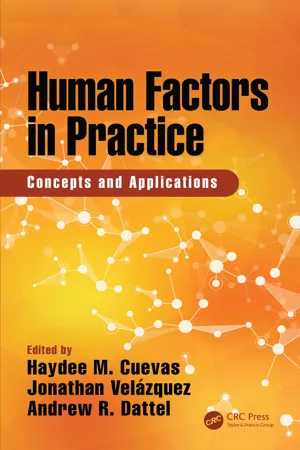
Human Factors in Practice
Concepts and Applications
- 160 pages
- English
- ePUB (mobile friendly)
- Available on iOS & Android
Human Factors in Practice
Concepts and Applications
About this book
Human Factors in Practice: Concepts and Applications is written for the practitioner who wishes to learn about human factors (HF) but is more interested in application (applied research) than theory (basic research). Each chapter discusses the application of important human factors theories, principles and concepts, presented at a level that can be easily understood by layman readers with no prior knowledge or formal education in human factors. The book illustrates to the non-HF practitioner the many varied domains in which human factors has been applied as well as serving to showcase current research in these areas. All chapters address the common overarching theme of applying human factors theories, principles and concepts to address real-world problems, and follow a similar structure to ensure consistency across chapters. Standard sections within each chapter include a discussion of the scientific underpinnings, a description of relevant HF methods and guidance on sources of further information, case studies to illustrate application, and a summary of likely future trends. Each chapter concludes with a short list of key terms and definitions to enhance the reader's understanding of the content. Featuring specialist contributors from a variety of disciplines and cultural backgrounds, the book represents a diverse range of perspectives on human factors and will appeal to a broad international audience. It is consciously not a classroom textbook but rather intended to be read at the workplace by non-HF practitioners, and written specifically with their needs in mind. Reading this book will give all practitioners a solid grounding in modern human factors and its application in real-world situations.
Frequently asked questions
- Essential is ideal for learners and professionals who enjoy exploring a wide range of subjects. Access the Essential Library with 800,000+ trusted titles and best-sellers across business, personal growth, and the humanities. Includes unlimited reading time and Standard Read Aloud voice.
- Complete: Perfect for advanced learners and researchers needing full, unrestricted access. Unlock 1.4M+ books across hundreds of subjects, including academic and specialized titles. The Complete Plan also includes advanced features like Premium Read Aloud and Research Assistant.
Please note we cannot support devices running on iOS 13 and Android 7 or earlier. Learn more about using the app.
Information
Section IOperator-Specific Considerations
2Senses in Action
Introduction
Fundamentals
What Are the Senses?
Sight (Vision, Ophthalmoception)
Table of contents
- Cover
- Half Title Page
- Title Page
- Copyright Page
- Dedication
- Contents
- Foreword
- Editors
- Contributors
- Section I Operator-Specific Considerations
- Section II System and Environmental Considerations
- Section III Putting Human Factors into Practice
- Index